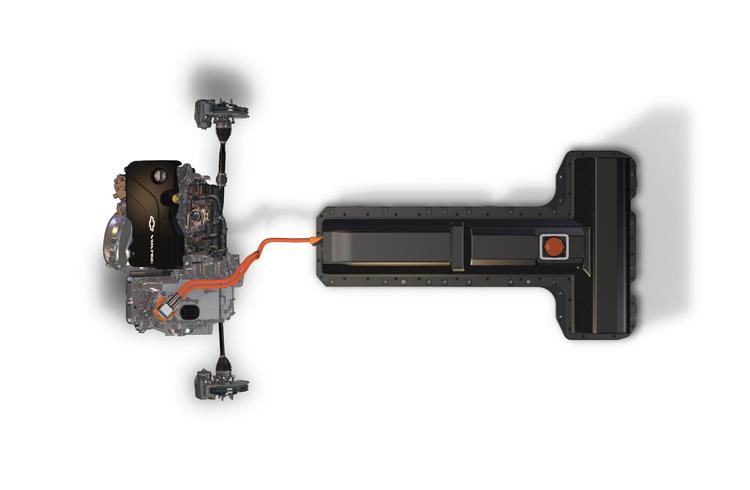Next-gen Chevrolet Volt features all-new Voltec propulsion system for more efficiency
When the next-generation Chevrolet Volt debuts at the North American International Auto Show in January
When the next-generation Chevrolet Volt debuts at the North American International Auto Show in January, it will feature an all-new Voltec extended range electric vehicle (EREV) propulsion system substantially developed from Volt owners including data collected on their driving behaviors.
The Voltec system includes the battery, drive unit, range-extending engine and power electronics. The new system will be more efficient and offer greater EV range and fuel economy compared to the current generation.
“Our Volt owners truly love the EV driving experience, with more than 80 percent of all trips being completed without using any petrol. We’ve used their real-world experiences to define the next generation Chevrolet Volt,” said Alan Batey, head of global Chevrolet. “By putting our Volt owners at the center of what we do and leveraging our electrification engineering leadership, we’ve been able to raise the bar and will exceed their expectations with the new Volt.”
Enhanced Battery System Capability
General Motors’ industry-leading battery technology has been improved for the next-generation Volt. Revised cell chemistry, developed in conjunction with LG Chem, increases storage capacity by 20 percent on a volume basis when compared to the original cell, while the number of cells decreases from 288 to 192. The cells are positioned lower in the pack for improved (lower) centre of gravity and the overall mass of the pack has decreased by almost 30 pounds (13 kg).
Approximately 20 million battery cells have been produced for the more than 69,000 Chevrolet Volts on the road today with industry-leading quality levels of less than two problems per million cells produced.
The battery system continues to use the Volt’s industry-leading active thermal control system that maintains electric range over the Volt’s life.
“The current generation Volt’s battery has proven to provide our owners exceptional performance when it comes to quality and reliability,” said Larry Nitz, executive director of GM Powertrain’s electrification engineering team.
Based on a GM study of more than 300 model year 2011 and 2012 Volts in service in California for more than 30 months, many owners are exceeding the EPA-rated label of 35 miles/56km of EV range per full charge, with about 15 percent surpassing 40 miles/64km of range. Current generation Volt owners have accumulated more than 600 million EV miles.
“It would have been simple for us to tweak our existing battery to provide nominally increased range, but that’s not what our customers want,” said Nitz. “So our team created a new battery system that will exceed the performance expectations of most of our owners.”
EV range estimates will be revealed in January at the North American International Auto Show in Detroit.
GM will manufacture the Volt battery pack at its battery assembly plant in Brownstown, Mich.
Drive Unit Focused On Improved Efficiency
Like the battery system, the next-generation Volt’s drive unit was reengineered with a focus on increased efficiency and performance, improved packaging and reduced noise and vibration characteristics. The two-motor drive unit operates approximately 5 to 12 percent more efficiently and weighs 100 pounds (45kg) less than the current system.
The Traction Power Inverter Module, which manages power flow between the battery and the electric drive motors, has been directly built into the drive unit to reduce mass, size and build complexity while further improving efficiency.
The boost in performance comes from both motors operating together in more driving scenarios, in both EV and extended-range operation. The ability to use both motors helps deliver more than 20 percent improvement in electric acceleration. GM engineers designed the Voltec electric motors to use significantly less rare earth materials. One motor uses no rare earth-type magnets at all.
The new drive unit will be manufactured at GM’s Powertrain plant in Warren, Mich.
New 1.5L Range Extender
Energy for extended-range operation comes from an all-new, high-efficiency 1.5-litre 4-cylinder engine. The engine features a direct injection fuel system, high-compression ratio of 12.5:1, cooled exhaust gas recirculation and a variable displacement oil pump. The Voltec range extender runs on regular unleaded fuel.
“Using the 1.5L engine as the range extender assures owners they can go anywhere, anytime without having to worry about whether they have enough power to go through the Rocky Mountains or on a spontaneous weekend getaway,” Nitz said. “It’s all about keeping the promise that the Volt is a no-compromise electric vehicle.”
The 1.5-litre engine will be manufactured at GM’s Toluca, Mexico engine plant for the first year of production, then shift to the Flint, Mich. engine plant.
The 2016 Chevrolet Volt will feature an all-new Voltec propulsion system that is made up of the battery, drive unit, range extending engine and electronic controls.
RELATED ARTICLES
Lamborghini unveils Urus SE ahead of Auto China 2024
Electric-only range of 60km helps reduce emissions by 80%.
ZF to display next-gen e-axle for low-floor city buses at Busworld Turkiye 2024
The AxTrax 2 LF is available with a continuous output of up to 360 kW and a peak torque of up to 37,300 Nm.
Daimler Buses and BMZ Poland to develop next-gen NMC4 electric bus batteries
The new battery generation NMC4 – succeeding the current NMC3 technology – will combine high energy density, resulting i...





 By Autocar Pro News Desk
By Autocar Pro News Desk
 29 Oct 2014
29 Oct 2014
 2384 Views
2384 Views









